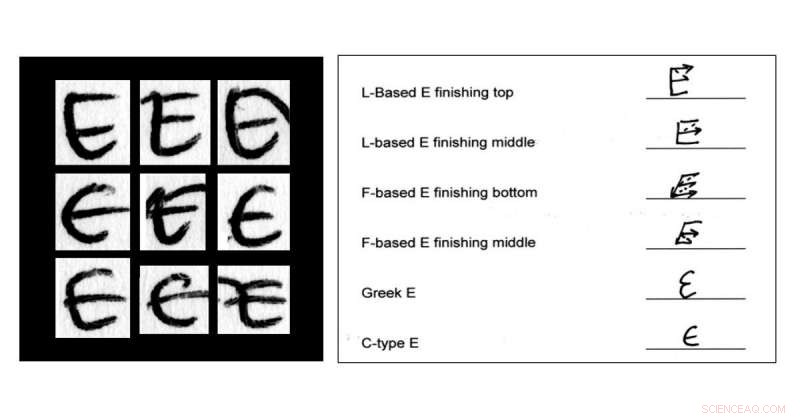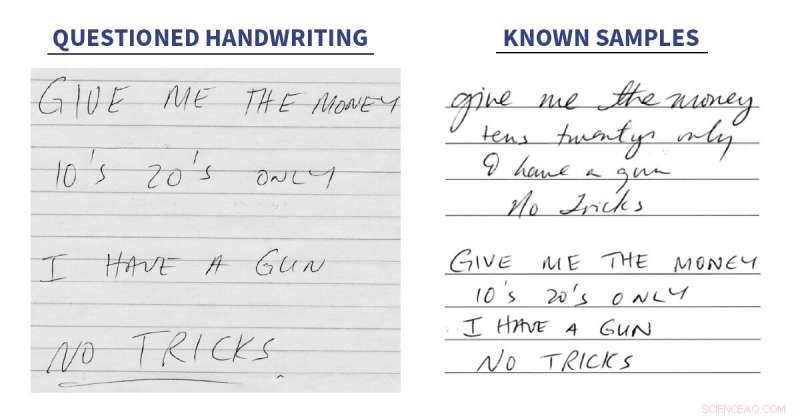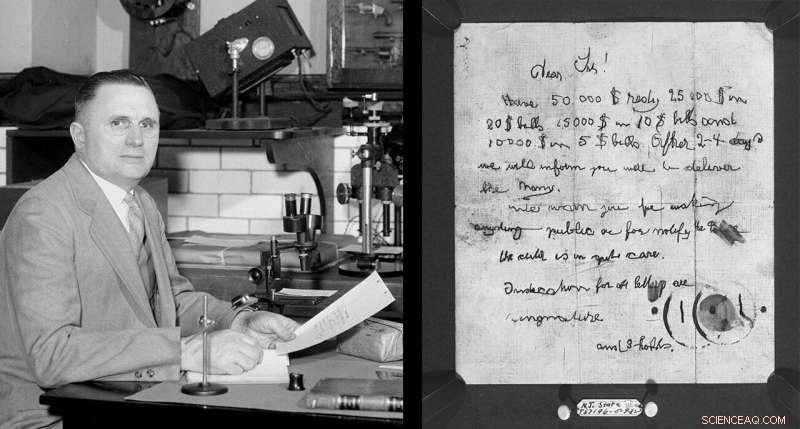
En rad naturliga variationer i en författares versaler "E". Kredit:NIST
Människor skriver mer än någonsin med sina tangentbord och telefoner, men handskrivna anteckningar har blivit sällsynta. Även signaturer går ur stil. De flesta kreditkortsköp kräver dem inte längre, och om de gör det, du kan vanligtvis bara skrapa ut en med nageln. Den urgamla konsten att skriva handstil är på tillbakagång.
Detta markerar en djupgående förändring i hur vi kommunicerar, men för en grupp experter väcker det också en existentiell fråga. Forensiska handskriftsgranskare autentiserar handskrivna anteckningar och signaturer – eller avslöjar att de är förfalskningar – genom att analysera särdrag i vårt skrivande. När folk skriver mindre för hand, blir handskriftsundersökning irrelevant?
En färsk rapport från National Institute of Standards and Technology (NIST) tyder på att svaret är nej - om området förändras för att hänga med i tiden. Men tiderna förändras på mer än ett sätt, och nedgången i handstil är bara en av utmaningarna som fältet kommer att behöva räkna med.
Hur experterna gör det
Emily Will är en styrelsecertifierad handskriftsexaminator i privat praktik i North Carolina. Hon har granskat underskrifter på otaliga kontroller, testamenten, gärningar och förtroende. Hon har granskat journaler för att bedöma om en läkares underskrift kan ha tillkommit vid ett senare tillfälle än vad som anges, kanske efter att en stämningsansökan väckts. Hon har också undersökt längre former av skrivande, som hotfulla eller trakasserande brev och självmordsbrev. Om det skenbara självmordsoffret inte skrev lappen, polisen kan ha ett mord på sina händer.
För att bedöma om en handstil skrevs av en viss person, examinatorer behöver något att jämföra det med, så de samlar in skrivprover som man vet är från den personen. Typen av skrift måste vara densamma, om en signatur, kursivstil, eller handtryck. De kända proverna bör vara från ungefär samma tidsperiod som handstilen i fråga, eftersom vår handstil utvecklas med tiden. Och att ha flera kända prov att jämföra med är nyckeln, eftersom det gör det möjligt för examinatorn att överväga variationen i en persons skrivstil.
"Du är inte en robot, så varje gång du skriver under ditt namn, det kommer se annorlunda ut, " sa Will. "Det är det som gör handskriftsundersökning så intressant."
Icke-professionella kanske tror att eftersom de flesta människor vet hur man producerar handstil, i stort sett vem som helst kan undersöka det. De kan anta att experten jämför sådana saker som storleken, lutning och avstånd mellan bokstäverna och kopplingarna mellan dem. Verkligen, examinatorer gör det. Men de ser också bortom dessa egenskaper hos skrivandet efter subtilare tecken på hur skriften gjordes.
"Säg att du vill förfalska en signatur, " sa Will. "Du kanske kan köra en bra faksimil. Men är "O" medsols när det ska vara moturs? Finns det pennlyft där det inte borde finnas? När du skriver under ditt namn är det bara muskelminne. Men att förfalska en signatur kräver övervägande. Pennan saktar ner. Den stannar och startar ." Dessa tveksamheter dyker upp under ett mikroskop som små bläckpölar.
"Det är inte så mycket hur signaturen ser ut, men hur det utfördes är viktigt, " sa Will.
Här är vad Will har med sig i sin go-väska:en juvelerarlupp, ett litet optiskt mikroskop och ett handhållet digitalt mikroskop. En ficklampa. En pappersmikrometer, för att mäta tjockleken på papper. En bärbar dator och en bärbar skanner. En kamera som kopplas till hennes mikroskop. "Och ärligt talat, " hon säger, "Jag använder min iPhone mycket nu för tiden."
Wills praxis sträcker sig till det bredare fältet "granskning av ifrågasatta dokument, " som innebär att granska ett helt dokument för tecken på bedrägeri. På hennes labb, hon har utrustning för att analysera papper och bläck och se dem under olika typer av ljus. Vissa bläck som ser identiska ut i dagsljus ser helt olika ut under infraröd. Hon identifierar raderingar, ändringar och utplåningar och avslöjar indragen skrift - de avtryck som lämnats på pappersark under den skrivna lappen.
Men det mesta av Wills arbete involverar handstil och underskrifter, och det är mycket färre av dem nuförtiden. Checkinlösen bedrägeri är långt ner nu när lönecheckar och sociala checkar är direkt insatta. Rättegångar om medicinsk felbehandling innebär färre underskrifter eftersom elektroniska journaler har blivit normen. Even celebrities have noticed the change. In a 2014 opinion article in The Wall Street Journal, Taylor Swift wrote, "I haven't been asked for an autograph since the invention of the iPhone with a front-facing camera."
Enough handwriting still passes under Will's microscope to keep her in business. Men, hon säger, "If I were a young person starting out today, I might consider cybersecurity."

Forensic handwriting examiners can only compare writing of the same type. I detta fall, only the second known sample can be compared to the questioned handwriting. Credit:NIST
A Roadmap for Staying Relevant
The field of forensic handwriting examination may have trouble attracting new blood. A report from NIST earlier this year found that the median age for handwriting examiners is 60, compared with 42 to 44 for people in similar scientific and technical occupations. Den rapporten, Forensic Handwriting Examination and Human Factors:Improving the Practice Through a Systems Approach, was published by NIST, but was written by 23 outside experts, including Will.
To increase recruitment, the report recommends replacing the unpaid apprenticeships that have been the traditional route of entry into the field with grants and fellowships. The report also recommends cross-training with other forensic disciplines that involve pattern matching, such as fingerprint examination.
The "human factors" in the report's title refers to a field of study that seeks to understand the factors that affect human capability and job performance. In forensic science, these include training, kommunikation, technology and management policies, för att nämna några stycken.
Melissa Taylor, the NIST human factors expert who led the group of authors, said that the report provides the forensic handwriting community with a road map for staying relevant. But the threat of irrelevance doesn't come only from the decline in handwriting. Part of the challenge, hon säger, arises from the field of forensic science itself.
"There is a big push toward greater reliability and more rigorous research in forensic science, sa Taylor, whose research is aimed at reducing errors and improving job performance in handwriting examination and other forensic disciplines, including fingerprints and DNA. "To stay relevant, the field of handwriting examination will have to change with the times."
Among other changes, the report recommends more research to estimate error rates for the field. This will allow juries and others to consider the potential for error when weighing an examiner's testimony. The report also recommends that experts avoid testifying in absolute terms or saying that an individual has written something to the exclusion of all other writers. Istället, experts should report their findings in terms of relative probabilities and degrees of certainty.
These recommendations are consistent with findings in a landmark 2009 report from the National Academy of Sciences. Called Strengthening Forensic Science in the United States:A Path Forward, that report said that "there may be a scientific basis for handwriting comparison, " but that there has been only limited research on its reliability.
Knowing When to Not Make a Call
Children used to learn handwriting in school by copying letters and phrases from books that contained models of ideal penmanship. Different copybooks had different styles, and an expert could often tell from a person's handwriting whether they were trained in the Palmer style, the Spencer style, or something else. By identifying a specific copybook style, an examiner could quickly narrow the range of potential writers.
Many children no longer learn cursive writing in school, and whether this helps or hinders handwriting examination is unknown. "It might actually make handwriting more identifiable because it allows people to develop their own individual styles of writing, " said Linton Mohammed, author of the widely used textbook Forensic Examination of Signatures, and a co-author of the NIST-led study.
Å andra sidan, it might make the task harder by depriving experts of a system for classifying writing styles. This is one reason why research on error rates is needed. The way people learn to write has changed, and error-rate studies can show whether handwriting examiners are successfully adapting to those changes. "We claim to be good at this, " Mohammed said. "But how good are we really?"
Several studies have attempted to answer this question by testing whether experts are more competent at handwriting examination than people with no training. The results reveal a great deal about both handwriting examination and human psychology.

In the 1930s, a physicist at NIST, then known as the National Bureau of Standards, became a leading handwriting expert. His name was Wilmer Souder, and the most famous case he worked on was 1932 the kidnapping of Charles Lindberg Jr., the infant son of the famous aviator. Despite the notoriety of this case, Souder himself kept an extremely low profile — so much so that when he retired, a profile in "Reader's Digest" referred to him as Detective X. Credit:NBS/NIST; source:NARA
In many of these studies, participants are shown pairs of signatures and asked to determine whether they are both by the same person or if one is a fake. Calculating overall error rates from multiple studies is difficult due to differences in study design. But consistently, across studies, both experts and novices made roughly the same proportion of correct decisions, according to a 2018 metastudy led by Alice Towler at the University of New South Wales, Australia. The novices, dock, made a much higher proportion of errors, while the experts more frequently declined to make a call. If a signature lacked complexity or was otherwise difficult to compare, the experts would more readily find the evidence inconclusive. This ability to defer judgment is critical to reducing errors in forensic science.
The tendency of novices to rush to judgment in cases where experts defer reflects a quirk of human psychology. People with limited knowledge or expertise in a subject often overestimate their own competence. This is called the Dunning-Kruger effect, for the psychologists who first described it. In the case of handwriting, people might be particularly susceptible. Trots allt, pretty much anyone can produce handwriting. How hard can it be to examine?
But error rate studies show that at least some experts recognize their limitations when faced with a difficult task. "I've been doing this for 30-plus years, and I realized early on that there's a lot that we don't know, " Mohammed said. "So we have to be very careful in reaching our conclusions."
The End of Handwriting Examination, or a New Beginning?
Like Emily Will, Mohammed has examined many wills, deeds and trusts. He has also analyzed ransom notes, threatening letters, and one hit list. Being based in the San Francisco Bay Area, where the tech boom has minted many fortunes, he has also examined many stock-option grants and prenuptial agreements.
Although Mohammed started his career with the San Diego County Sheriff's Department, today he is in private practice. In his current home base of northern California, han säger, there are no government laboratories that still examine questioned documents. This reflects a nationwide trend—a report from the Department of Justice found that only 14% of publicly funded crime labs did their own questioned document examinations in 2014, down from 24% in 2002.
Those numbers may mean that the field is consolidating rather than disappearing. If smaller labs can no longer support in-house experts due to a diminishing caseload, they can farm out work to private sector experts like Will and Mohammed. På samma gång, larger federal labs, including the FBI Laboratory and the U.S. Army's Defense Forensic Science Center, continue to maintain questioned document units. This is in part because their focus includes international terrorism, where handwritten documents are still a source of valuable intelligence, and in part because the United States is a big place. Rikstäckande, crimes involving handwriting still occur frequently enough that federal labs need to keep experts on staff.
When asked if handwriting examiners will soon become irrelevant, one federal expert said that as long as greed and fraud exist, there will be a need for handwriting examiners.
When asked the same question, Mohammed noted that changing technology did not doom the field in the past. "When the ballpoint pen came out, people said, "That's the end of handwriting examination, '" he said. People mostly stopped using fountain pens, but handwriting examination survived the transition.
Melissa Taylor, the NIST expert, agrees that handwriting examination is still a needed skill and will remain relevant—if the field successfully adapts to changing expectations around research and reliability. And if the new report, which counts many leading handwriting experts among its authors, is any indication, the needed changes may already be underway.
"There will still be documents. There will still be signatures, " Taylor said. "And most people don't print stickup notes on their laser printer. They scribble them on the dashboard before running into the bank."
Some things will never change.